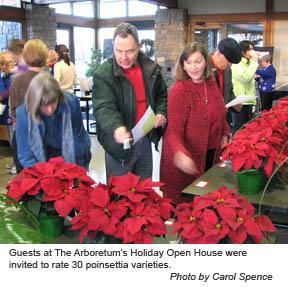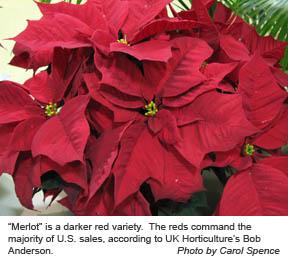Kentucky Growers Color the Season
Kentucky Growers Color the Season

They’re everywhere you look this time of year. Their hues of scarlet, burgundy, pink and white splash tables and mantels with color. Store displays and hotel lobbies are brightened by their presence. Church altars are blanketed with them. Poinsettias are synonymous with the Christmas season and each year Kentucky growers are eager to supply them.
The Kentucky greenhouse industry produces approximately 600,000 poinsettia plants each year, resulting in seasonal sales of $3 million, said Bob Anderson, University of Kentucky Cooperative Extension professor in horticulture. The plants arrive as cuttings around Aug. 15. Many of those cuttings are grown offshore in Mexico, Central America or as far away as the Canary Islands. They’re shipped into the United States without roots, because U.S. Customs regulations prohibit them from being shipped with soil. Once they’re in the United States, they’re rooted and distributed to the growers.
Americans were introduced to poinsettias in the early 19th century by the first U.S. ambassador to Mexico, Joel Roberts Poinsett. Poinsett, who found them growing as weeds by the side of a road, sent the plants home to Greenville, S.C. Outside, in the warm climate zones they prefer, poinsettias will typically grow 6 to 10 feet tall. The three-month growth period of a hothouse poinsettia results in the smaller, bushier plants that people have become accustomed to seeing.
In Mexico, the plants carry with them a legend, told in various ways with different names and slightly different plot twists. All the stories, though, center on the plight of a small child who is too poor to bring a gift to place before the manger in her church’s nativity scene. One version tells of an angel who appears to the child and instructs her to bring a weed from the side of the road. In other versions, the child, or children, chooses to bring the weed on her own. But in all versions, when the weed is brought to the manger, its leaves miraculously become a bright and beautiful swirl of scarlet with clusters of yellow gold at their center.
What we call “flowers” on a poinsettia are not really flowers at all. The bracts, or leaves, at the top of each stem turn a vivid color, making them resemble a blossom. The plant’s flowers are actually the small yellow clusters found in the center of the bracts. Currently there are about 150 varieties of the plant on the market, Anderson said. This year, 30 of those varieties are on display in Lexington at The Arboretum, the State Botanical Garden of Kentucky. Grown at the UK Horticulture Research Farm in Lexington, their colors range from creamy white through pink, red, and burgundy. Some show off multiple colors in a marbled pattern. Visitors were asked to rate the plants based on whether they would purchase such a variety.
Currently there are about 150 varieties of the plant on the market, Anderson said. This year, 30 of those varieties are on display in Lexington at The Arboretum, the State Botanical Garden of Kentucky. Grown at the UK Horticulture Research Farm in Lexington, their colors range from creamy white through pink, red, and burgundy. Some show off multiple colors in a marbled pattern. Visitors were asked to rate the plants based on whether they would purchase such a variety.
“The growers are very interested in what regular folks think is a great poinsettia,” said Roberta Burnes, education coordinator at The Arboretum. “Some of them look, at first, like they’re exactly the same, but if you look closer, you see details and differences.”
Jan Czochara attended The Arboretum’s Holiday Open House and took the time to evaluate the plants. Her favorite was a burgundy-colored variety named “Merlot.” “I like the darker red color and I also like the unusual shape of leaf,” she said. “See how they almost look more like an oak leaf versus the usual teardrop?”
“I like the darker red color and I also like the unusual shape of leaf,” she said. “See how they almost look more like an oak leaf versus the usual teardrop?”
Among other varieties on display were Amazing Pink, Santa Claus White, Cinnamon Candy and a series of poinsettias carrying the Premium name that included plants in all hues.
The industry is driven by consumer preferences, Anderson said. Some breeders breed new types to see what the consumer will like. That’s why every year there are a few “novelty” types in the stores, just to see if consumers will pick up on them, he said.
“There were a set of varieties introduced five years ago that were really quite maroon in color and growers said, ‘I’m not going to grow those.’ But when they put them out on the market, the public loved them. So it changed what people (growers) thought of them,” Anderson said.
Using poinsettias can add instant excitement to a holiday decorating scheme. With some simple care, they can last beyond the holidays. Water the plant when it is dry and don’t allow it to sit in a saucer filled with water. Poinsettias like bright, natural light with some direct sunlight for at least three hours a day. Keep them away from drafts and fertilize occasionally with an ordinary houseplant fertilizer.
And for those who might worry about pets or small children being around the plants, Anderson says those worries are unfounded. Poinsettias are not poisonous. Extensive studies conducted at Ohio State University and at Pittsburgh’s Duquesne University “showed no toxicity, no changes in behavior and no mortality even at extremely high dosages,” according to a UK horticulture publication written by Anderson.
“It’s a matter of the plant being in a family that has poisonous plants in it, so people sort of assume they (poinsettias) are poisonous, too,” he said.
Nonetheless, he advises people to be aware that poinsettias, like other houseplants, are not intended to be eaten and can cause, in some people, discomfort if consumed.
“Allergies and those kinds of reactions can happen to anyone. The industry assumes that when we sell it, nobody’s going to eat it. They’re not thinking that it’s lettuce,” he said, chuckling. “It’s just something there for the ornamental value.”
